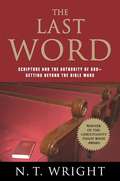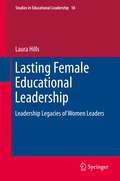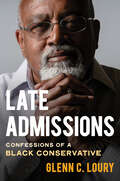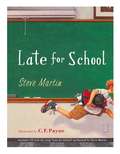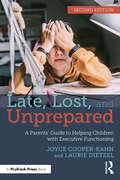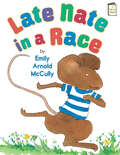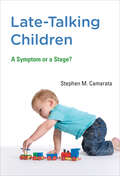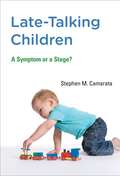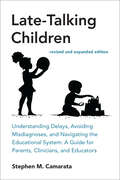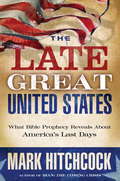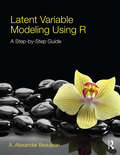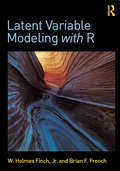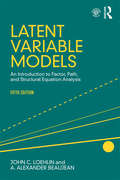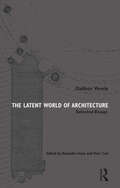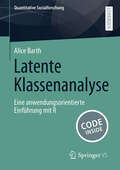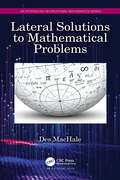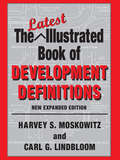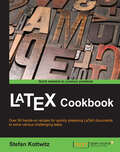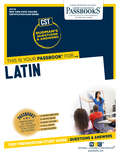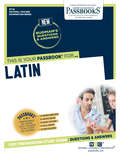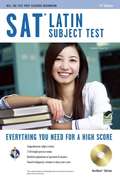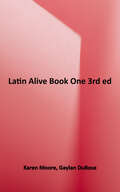- Table View
- List View
The Last Word
by N. T. WrightWhile showing how both evangelicals and liberals misread Scripture, a leading Bible scholar and Anglican bishop shows how to restore the Bible's authority today for guiding the church through its many controversies.
Lasting Female Educational Leadership
by Laura HillsOur colleges and universities are being led in large part by baby boomers who are now in later midlife. Huge numbers of those middle-aged leaders will retire within the next 10 years. While we know that being in later midlife and impending retirement must influence a person in a leadership position at an institution of higher learning, we don't really understand how. This book is based upon an empirical study that linked higher education leadership to one aspect of midlife known as generativity. This psychosocial phenomenon was described by Erik Erikson as a desire that peaks in midlife to leave something for future generations before one dies. Generativity typically manifests itself in the legacy one intends to leave. The author of this book has completed a multiple case study of women who are in later midlife and who hold high-level leadership positions at an institution of higher learning. In this work, she shares more than has ever been known about the nature, antecedents, and support of generativity in the leadership of female higher education leaders in midlife.
A Lasting Peace: A Historical, Biblical, and Prophetic Lens on the Crisis in the Middle East
by Jonathan BernisThe crisis in the Middle East is not a political issue. It's a spiritual issue. Rapidly unfolding events in the Middle East will shape the future, not just of Israel but of our entire world. This insightful commentary by Rabbi Jonathan Bernis combines historical, biblical, and prophetic teaching to help you understand what&’s happening and how Believers should respond to these events. Drawing from the perspective of a Jewish Believer in Jesus, this book provides a biblical understanding of the complex issues continuing to unfold in the Middle East today and how they relate to key prophecy in Scripture. Discover why there is constant upheaval in the Middle East, what to watch for in the days ahead, and whether peace is really possible. Other books by Rabbi Jonathan Bernis include:Unlocking the Prophetic Mysteries of IsraelA Hope and A Future
Late Admissions: Confessions of a Black Conservative
by Glenn LouryA shockingly frank memoir from a prize-winning economist, reflecting on his remarkable personal odyssey and his changing positions on identity, race, and belief. Economist Glenn C. Loury is one of the most prominent public intellectuals of our time: he’s often radically opposed to the political mainstream, and delights in upending what’s expected of a Black public figure. But more so than the arguments themselves—on affirmative action, institutional racism, Trumpism—his public life has been characterized by fearlessness and a willingness to recalibrate strongly held and forcefully argued beliefs. Loury grew up on the south side of Chicago, earned a PhD in MIT’s economics program, and became the first Black tenured professor of economics at Harvard at the age of thirty-three. He has been, at turns, a young father, a drug addict, an adulterer, a psychiatric patient, a born-again Christian, a lapsed born-again Christian, a Black Reaganite who has swung from the right to the left and back again. In Late Admissions, Loury examines what it means to chart a sense of self over the course of a tempestuous, but well-considered, life.
Late for School
by Steve Martin C. F. PayneGetting to school has never been quite this difficult--or hilarious. Celebrated writer and performer Steve Martin and dynamic artist C. F. Payne (illustrator of John Lithgow's children's books) have teamed up to tell a story of the adventure, danger, and laughs of the journey to school. Undoubtedly a new classic for readers of all ages,
The Late Great Planet Earth
by Carole C. Carlson Hal LindseyThe impact of The Late Great Planet Earth cannot be overstated. The New York Times called it the "no. 1 non-fiction bestseller of the decade." For Christians and non-Christians of the 1970s, Hal Lindsey's blockbuster served as a wake-up call on events soon to come and events already unfolding -- all leading up to the greatest event of all: the return of Jesus Christ. The years since have confirmed Lindsey's insights into what biblical prophecy says about the times we live in. Whether you're a church-going believer or someone who wouldn't darken the door of a Christian institution, the Bible has much to tell you about the imminent future of this planet. In the midst of an out-of-control generation, it reveals a grand design that's unfolding exactly according to plan. The rebirth of Israel. The threat of war in the Middle East. An increase in natural catastrophes. The revival of Satanism and witchcraft. These and other signs, foreseen by prophets from Moses to Jesus, portend the coming of an antichrist . . . of a war which will bring humanity to the brink of destruction . . . and of incredible deliverance for a desperate, dying planet.
The Late Great Planet Earth
by Hal Lindsey C. C. CarlsonA look at what biblical prophecy tells us about our times, the future, and the return of Jesus Christ.
Late, Lost, and Unprepared: A Parents’ Guide to Helping Children with Executive Functioning
by Joyce Cooper-Kahn Laurie DietzelDoes your child have difficulty meeting deadlines, staying organized, or keeping track of important information? Do they tend to forget details? Are they prone to emotional meltdowns? This book will become your go-to, all-inclusive guide to helping children manage issues with these executive functions, a set of related yet distinct mental skills that allow us to stay on target as we work toward our goals.Packed with encouragement, strategies, overviews, case studies, tips, and more, this newly revised edition offers science-based information explained in accessible, everyday language. You will find down to earth examples and a flexible framework that allows you to think on your feet and adapt the strategies to any child or situation.In addition to providing approaches for helping your child to manage demands in the short run, this book offers strategies for building independent skills for long-term self-management. Covering what you need to know, as well as what you can do, Late, Lost, and Unprepared gives parents the support they need to help their child become productive and independent – today and in the future.
Late Nate in a Race (I Like to Read)
by Emily Arnold McCullyOn the day of the race, Nate is running late. Find out what happens when he tries out going fast in this Guided Reading Level D story. Nate likes to go slow. His brother and sister are worried they'll miss the race—but mom tells them not to nag him. When they get there, Mom convinces Nate to try, too. . . . And Nate finds out sometimes he likes to go slow, but sometimes he likes to go fast! With colorful, kid-friendly illustrations by Caldecott Honor artist Emily Arnold McCully, this simple story about the rewards of trying new things is perfect for emergent readers. The award-winning I Like to Read® series focuses on guided reading levels A through G, based upon Fountas and Pinnell standards. Acclaimed author-illustrators--including winners of Caldecott, Theodor Seuss Geisel, and Coretta Scott King honors—create original, high quality illustrations that support comprehension of simple text and are fun for kids to read with parents, teachers, or on their own! Suitable for late kindergarten readers, Level D books feature wider vocabulary, longer sentences, and greater variety in sentence structure than levels A, B, and C. When Level D is mastered, follow up with Level E.
Late-Talking Children: A Symptom or a Stage? (The\mit Press Ser.)
by Stephen M. CamarataWhat parents need to know about the causes and treatment of children's late talking: how to avoid misdiagnoses, navigate the educational system, and more.When children are late in hitting developmental milestones, parents worry. And no delay causes more parental anxiety than late talking, which is associated in many parents' minds with such serious conditions as autism and severe intellectual disability. In fact, as children's speech expert Stephen Camarata points out in this enlightening book, children are late in beginning to talk for a wide variety of reasons. For some children, late talking may be a symptom of other, more serious, problems; for many others, however, it may simply be a stage with no long-term complications.Camarata describes in accessible language what science knows about the characteristics and causes of late talking. He explains that late talking is only one of a constellation of autism symptoms. Although all autistic children are late talkers, not all late-talking children are autistic. Camarata draws on more than twenty-five years of professional experience diagnosing and treating late talkers—and on his personal experience of being a late talker himself and having a late-talking son. He provides information that will help parents navigate the maze of doctors, speech therapists, early childhood services, and special education; and he describes the effect that late talking may have on children's post-talking learning styles.
Late-Talking Children
by Stephen M. CamarataWhen children are late in hitting developmental milestones, parents worry. And no delay causes more parental anxiety than late talking, which is associated in many parents' minds with such serious conditions as autism and severe intellectual disability. In fact, as children's speech expert Stephen Camarata points out in this enlightening book, children are late in beginning to talk for a wide variety of reasons. For some children, late talking may be a symptom of other, more serious, problems; for many others, however, it may simply be a stage with no long-term complications. Camarata describes in accessible language what science knows about the characteristics and causes of late talking. He explains that today's greater awareness of autism, as well as the expanded definition of autism as a "spectrum" of symptoms, has increased the chances that a late-talking child will be diagnosed -- or misdiagnosed -- with autism. But, he reminds us, late talking is only one of a constellation of autism symptoms. Although all autistic children are late talkers, not all late-talking children are autistic. Camarata draws on more than twenty-five years of professional experience diagnosing and treating late talkers -- and on his personal experience of being a late talker himself and having a late-talking son. Camarata offers parents valuable guidance on seeking treatment, advising them to get second and third opinions if necessary, and warning them against false diagnoses, unqualified practitioners, and ineffective therapies. He provides information that will help parents navigate the maze of doctors, speech therapists, early childhood services, and special education; and he describes the effect that late talking may have on children's post-talking learning styles.
Late-Talking Children, revised and expanded edition: Understanding Delays, Avoiding Misdiagnoses, and Navigating the Educational System: A Guide for Parents, Clinicians, and Educators
by Stephen M. CamarataA revised and expanded edition of the bestselling guide to late-talking children for parents, clinicians, and educators, from a leading authority on development and disabilities.Every year in America, more than half a million parents of late-talking children face agonizing questions: What should I do if my two- or even three-year-old has not yet begun to talk? Should I worry that my child is autistic or intellectually disabled? Are expensive therapies or medications needed? Will my child ever speak normally? In this revised and expanded edition of the essential resource on the subject, Late-Talking Children, Stephen Camarata—the parent of a late-talking child and a late talker himself—provides clear, sensible, and compassionate answers for parents, clinicians, and educators, drawing on his more than three decades of experience diagnosing and treating the &“late-talking syndrome&” as well as the best science available today.
The Late United States: What Bible Prophecy Reveals About America's Last Days
by Mark HitchcockIs it possible the United States, a superpower without peer in history, might not be a key player as the world makes its way down the road to the Battle of Armageddon? This is the central question explored by prophecy expert Mark Hitchcock inThe Late Great United States,a fascinating behind-the-headlines look at numerous current events and how they relate to what the Bible says about the last days. Americans are accustomed to seeing their country center stage as a world power, but as Hitchcock carefully details, this may not be the case inthefinal scene. Based on extensive research of the Bible and other sources,The Late Great United Statesprovides compelling and often surprising answers to questions like these: •Does the Bible say anything about America in the last days? •How could the U. S. fit into God’s prophetic plan? •Will America survive? •Might the anti-Christ come from America? •Could America’s addiction to oil be her undoing? •Will America be destroyed by a nuclear attack? •Could America fall from within as a result of moral corruption? •Is America still a “blessed” nation? •How should individual Christians respond to a world in chaos? Regardless of America's final fate and the outcome of dire events at the end of the age, Hitchcock urges us to find our hope in a God who will not forsake us–no matter what cataclysms we experience on earth. From the Hardcover edition.
Latent Variable Modeling Using R: A Step-by-Step Guide
by A. Alexander BeaujeanThis step-by-step guide is written for R and latent variable model (LVM) novices. Utilizing a path model approach and focusing on the lavaan package, this book is designed to help readers quickly understand LVMs and their analysis in R. The author reviews the reasoning behind the syntax selected and provides examples that demonstrate how to analyze data for a variety of LVMs.? Featuring examples applicable to psychology, education, business, and other social and health sciences, minimal text is devoted to theoretical underpinnings. The material is presented without?the use of matrix algebra. As a whole the book prepares readers to write about and interpret LVM results they obtain in R. Each chapter features background information, boldfaced key? terms defined in the glossary, detailed interpretations of R output, descriptions of how to write the analysis of results for publication, a summary, R based practice exercises (with solutions included in the back of the book), and references and related readings. Margin notes help readers better understand LVMs and write their own R syntax. Examples using data from published work across a variety of disciplines demonstrate how to use R syntax for analyzing and interpreting results. R functions, syntax, and the corresponding results appear in gray boxes to help readers quickly locate this material. A unique index helps readers quickly locate R?functions, packages, and datasets. The book and accompanying website at http://blogs.baylor.edu/rlatentvariable/ provides all of the data for the book’s examples and exercises as well as R syntax so readers can replicate the analyses. The book reviews how to enter the data into R, specify the LVMs, and obtain and interpret the estimated parameter values. The book opens with the fundamentals of using R including how to download the program, use functions, and enter and manipulate data. Chapters 2 and 3 introduce and then extend path models to include latent variables. Chapter 4 shows readers how to analyze a latent variable model with data from more than one group, while Chapter 5 shows how to analyze a latent variable model with data from more than one time period. Chapter 6 demonstrates the analysis of dichotomous variables, while Chapter 7 demonstrates how to analyze LVMs with missing data. Chapter 8 focuses on sample size determination using Monte Carlo methods, which can be used with a wide range of statistical models and account for missing data. The final chapter examines hierarchical LVMs, demonstrating both higher-order and bi-factor approaches. The book concludes with three Appendices: a review of common measures of model fit including their formulae and interpretation; syntax for other R latent variable models packages; and solutions for each chapter’s exercises. Intended as a supplementary text for graduate and/or advanced undergraduate courses on latent variable modeling, factor analysis, structural equation modeling, item response theory, measurement, or multivariate statistics taught in psychology, education, human development, business, economics, and social and health sciences, this book also appeals to researchers in these fields. Prerequisites include familiarity with basic statistical concepts, but knowledge of R is not assumed.
Latent Variable Modeling with R
by W. Holmes Finch Brian F. FrenchThis book demonstrates how to conduct latent variable modeling (LVM) in R by highlighting the features of each model, their specialized uses, examples, sample code and output, and an interpretation of the results. Each chapter features a detailed example including the analysis of the data using R, the relevant theory, the assumptions underlying the model, and other statistical details to help readers better understand the models and interpret the results. Every R command necessary for conducting the analyses is described along with the resulting output which provides readers with a template to follow when they apply the methods to their own data. The basic information pertinent to each model, the newest developments in these areas, and the relevant R code to use them are reviewed. Each chapter also features an introduction, summary, and suggested readings. A glossary of the text’s boldfaced key terms and key R commands serve as helpful resources. The book is accompanied by a website with exercises, an answer key, and the in-text example data sets. Latent Variable Modeling with R: -Provides some examples that use messy data providing a more realistic situation readers will encounter with their own data. -Reviews a wide range of LVMs including factor analysis, structural equation modeling, item response theory, and mixture models and advanced topics such as fitting nonlinear structural equation models, nonparametric item response theory models, and mixture regression models. -Demonstrates how data simulation can help researchers better understand statistical methods and assist in selecting the necessary sample size prior to collecting data. -www.routledge.com/9780415832458 provides exercises that apply the models along with annotated R output answer keys and the data that corresponds to the in-text examples so readers can replicate the results and check their work. The book opens with basic instructions in how to use R to read data, download functions, and conduct basic analyses. From there, each chapter is dedicated to a different latent variable model including exploratory and confirmatory factor analysis (CFA), structural equation modeling (SEM), multiple groups CFA/SEM, least squares estimation, growth curve models, mixture models, item response theory (both dichotomous and polytomous items), differential item functioning (DIF), and correspondance analysis. ?The book concludes with a discussion of how data simulation can be used to better understand the workings of a statistical method and assist researchers in deciding on the necessary sample size prior to collecting data.? A mixture of independently developed R code along with available libraries for simulating latent models in R are provided so readers can use these simulations to analyze data using the methods introduced in the previous chapters. Intended for use in graduate or advanced undergraduate courses in latent variable modeling, factor analysis, structural equation modeling, item response theory, measurement, or multivariate statistics taught in psychology, education, human development, and social and health sciences, researchers in these fields also appreciate this book’s practical approach. The book provides sufficient conceptual background information to serve as a standalone text.? Familiarity with basic statistical concepts is assumed but basic knowledge of R is not.
Latent Variable Models: An Introduction to Factor, Path, and Structural Equation Analysis, Fifth Edition
by John C. Loehlin A. Alexander BeaujeanLatent Variable Models: An Introduction to Factor, Path, and Structural Equation Analysis introduces latent variable models by utilizing path diagrams to explain the relationships in the models. This approach helps less mathematically-inclined readers to grasp the underlying relations among path analysis, factor analysis, and structural equation modeling, and to set up and carry out such analyses. This revised and expanded fifth edition again contains key chapters on path analysis, structural equation models, and exploratory factor analysis. In addition, it contains new material on composite reliability, models with categorical data, the minimum average partial procedure, bi-factor models, and communicating about latent variable models. The informal writing style and the numerous illustrative examples make the book accessible to readers of varying backgrounds. Notes at the end of each chapter expand the discussion and provide additional technical detail and references. Moreover, most chapters contain an extended example in which the authors work through one of the chapter’s examples in detail to aid readers in conducting similar analyses with their own data. The book and accompanying website provide all of the data for the book’s examples as well as syntax from latent variable programs so readers can replicate the analyses. The book can be used with any of a variety of computer programs, but special attention is paid to LISREL and R. An important resource for advanced students and researchers in numerous disciplines in the behavioral sciences, education, business, and health sciences, Latent Variable Models is a practical and readable reference for those seeking to understand or conduct an analysis using latent variables.
The Latent World of Architecture: Selected Essays
by Dalibor VeselyThis book features thirteen essays by the late architect, philosopher and teacher Dalibor Vesely (1934–2015). Vesely was a leading authority on philosophical hermeneutics and phenomenology in relation to architecture worldwide, and influenced a generation of thinkers, teachers and practitioners. This collection presents the full range of his writing, drawing primarily from the history of art and architecture, as well as philosophy, theology, anthropology and ecology, and spanning from early antiquity to modernism. It composes a multifaceted and globally relevant argument about the enduring cultural role of architecture and the significance of its history. The book, edited and introduced by Vesely’s teaching partner at Cambridge Peter Carl and former student Alexandra Stara, and with a foreword by David Leatherbarrow, brings to light new and hard-to-access material for those familiar with Vesely’s thought and, at the same time, offers a compelling introduction to his writing and its profound relevance for architecture and culture today.
Latente Klassenanalyse: Eine anwendungsorientierte Einführung mit R (Quantitative Sozialforschung)
by Alice BarthDas Buch bietet eine kompakte, anwendungsorientierte Einführung in die Technik der latenten Klassenanalyse. Grundlagen des Verfahrens sowie Voraussetzungen, praktische Anwendung und Ergebnisinterpretation werden verständlich erläutert. Die Analyse latenter Klassen ist ein statistisches Klassifikationsverfahren, bei dem mehrere kategoriale, manifeste Variablen zu vorher unbeobachteten Gruppen zugeordnet werden. So können z.B. aus einer Vielzahl von Variablen Typologien entwickelt werden. Für die Durchführung der Analysen wird die Open Source-Statistikumgebung R genutzt. Die verwendeten Syntaxbefehle sowie die Ausgabe der Ergebnisse werden erläutert, zusätzlich sind die kommentierte R-Syntax sowie Beispieldaten als elektronisches Zusatzmaterial im GitHub-Repositorium des Buches auf SpringerLink verfügbar. Die in den Beispielen verwendeten Daten haben keine Zugangsbeschränkung und können kostenfrei heruntergeladen werden, um die Analysen selbst nachzuvollziehen.
Lateral Solutions to Mathematical Problems (AK Peters/CRC Recreational Mathematics Series)
by Desmond MacHaleLateral Solutions to Mathematical Problems offers a fresh approach to mathematical problem solving via lateral thinking. Lateral thinking has long been used informally by good mathematics teachers and lecturers to spice up their material and interest their students in the more artistic aspects of mathematical problem solving. In this book, the author attempts to carry out this process formally, with reference to specific, non-technical problems that are easily understood and explained at an intermediate level.This book is appropriate for interested high school students, undergraduates and postgraduates, looking for relief from technical material and also looking for insight into the methodology of mathematics; for teachers and lecturers looking for a novel approach to course material; and anyone interested in both mathematics and lateral thinking.
The Latest Illustrated Book of Development Definitions
by Carl G. LindbloomIllustrated definitions are rarely found in zoning and development ordinances. Ordinances prefer the "thousand words" rather than the "single picture." Illustrations greatly simplify how standards should be applied, particularly where the lot or parcel is irregularly shaped or where there are a number of variables present, each of which might have an impact on how the ordinance might apply in a specific situation. This best-selling resource has been the mainstay of the planner's bookshelf since its first publication and it differs from other books and publications containing development definitions in three major respects: It is illustrated; most of the definitions are designed to be used directly in ordinances with little or no change; and the more complex definitions are accompanied by commentaries and annotations that explain how the definition may be used in an ordinance, along with background information pertinent to the definition. This expanded edition standardizes in one handy reference all the key terms used in zoning, subdivision, site plan, and environmental ordinances. In all, it contains 1,957 definitions and 103 illustrations that can be incorporated in local ordinances with little or no change. Written and illustrated by two professional planners with nearly eighty years of combined experience in the practice of planning and zoning, this is a basic working tool and required reference for anyone involved in land development planning and regulation.
LaTeX Cookbook: Over 90 hands-on recipes for quickly preparing LaTex documents to solve various challenging tasks
by Stefan KottwitzA pragmatic guide with actionable recipes on LaTex to apply for tuning text, custom designs, fonts, embedding images, tables, advanced mathematics, and graphics for all your complex documentsKey FeaturesWork with modern document classes, such as KOMA-Script classesExplore the latest LaTeX packages, including TikZ, pgfplots, and biblatexAn example-driven approach to creating stunning graphics directly within LaTeXBook DescriptionLaTeX is a high-quality typesetting software and is very popular, especially among scientists. Its programming language gives you full control over every aspect of your documents, no matter how complex they are. LaTeX's huge amount of customizable templates and supporting packages cover most aspects of writing with embedded typographic expertise.With this book you will learn to leverage the capabilities of the latest document classes and explore the functionalities of the newest packages.The book starts with examples of common document types. It provides you with samples for tuning text design, using fonts, embedding images, and creating legible tables. Common document parts such as the bibliography, glossary, and index are covered, with LaTeX's modern approach.You will learn how to create excellent graphics directly within LaTeX, including diagrams and plots quickly and easily.Finally, you will discover how to use the new engines XeTeX and LuaTeX for advanced programming and calculating with LaTeX.The example-driven approach of this book is sure to increase your productivity.What you will learnChoose the right document class for your project to customize its featuresUtilize fonts globally and locallyFrame, shape, arrange, and annotate imagesAdd a bibliography, a glossary, and an indexCreate colorful graphics including diagrams, flow charts, bar charts, trees, plots in 2d and 3d, time lines, and mindmapsSolve typical tasks for various sciences including math, physics, chemistry, electrotechnics, and computer scienceOptimize PDF output and enrich it with meta data, annotations, popups, animations, and fillin fieldsExplore the outstanding capabilities of the newest engines and formats such as XeLaTeX, LuaLaTeX, and LaTeX3Who this book is forIf you already know the basics of LaTeX and you like to get fast, efficient solutions, this is the perfect book for you. If you are an advanced reader, you can use this book's example-driven format to take your skillset to the next level. Some familiarity with the basic syntax of LaTeX and how to use the editor of your choice for compiling is required.
Latin: Passbooks Study Guide (New York State Teacher Certification Examination Series (NYSTCE))
by National Learning CorporationThe New York State Teacher Certification Exams (NYSTCE) are required for all candidates seeking licensure in the State. The NYSTCE series consists of many different tests assessing skills and abilities necessary for teachers. The Passbook® for the Content Specialty Test in Latin provides hundreds of multiple-choice questions in the areas that will likely be covered on your upcoming certification exam, including but not limited to: reading comprehension; language structure; cultural contributions and history; English derivatives; and other related areas.
LATIN: Passbooks Study Guide (National Teacher Examination Series (NTE))
by National Learning CorporationThe National Teacher/PRAXIS Examinations are designed to provide objective measurement of the knowledge, skills and abilities required of teachers. The Passbook® for the Latin exam provides hundreds of multiple-choice questions in the areas that will likely be covered on your upcoming certification test.
Latin (SAT PSAT ACT (College Admission) Prep Series)
by Ronald B. Palma<P>Taking the SAT Latin Subject Test? <P>Then REA's SAT Subject Test: Latin Test Prep with Practice Tests on CD is just for you! <P>Written by an experienced Latin teacher, this second edition of our bestselling SAT Subject Test: Latin test prep includes a comprehensive review of covers all language areas appearing on the actual exam including coverage of declensions, conjugations, sentence structure, and more. Each chapter contains numerous examples and practice questions, and tips that help students study smarter and boost their test scores. <P>The book includes two full-length practice tests that replicate the actual exam's question format. Both of the book's practice exams are featured on our TestWare CD with the most powerful scoring and diagnostic tools available today. Automatic scoring and instant reports help you zero in on the topics and types of questions that give you trouble now, so you'll succeed when it counts. <P>Detailed explanations of answers help you identify your strengths and weaknesses. We don't just say which answers are right - we also explain why the other answer choices are incorrect - so you'll be prepared on test day. <P>The book also includes study tips, strategies, and confidence-boosting advice you need for test day. <P>REA's test prep is a must for any high school student taking the SAT Latin Subject Test!
Latin Alive! (Latin Alive Series #Book One)
by Karen Moore Gaylan DuBoseStudents will be delighted by what they learn in each new chapter of Latin Alive!, Book One, and they will learn to see that Latin is everywhere around them. As the first text in a three-year series, it is a rigorous and thorough introduction to this great language and is designed to engage upper school (middle and high school) student. Brimming with relevant facts and stories this text offers something for everyone. A Teacher’s Edition including answer keys, teacher’s helps and additional activities is available separately.
